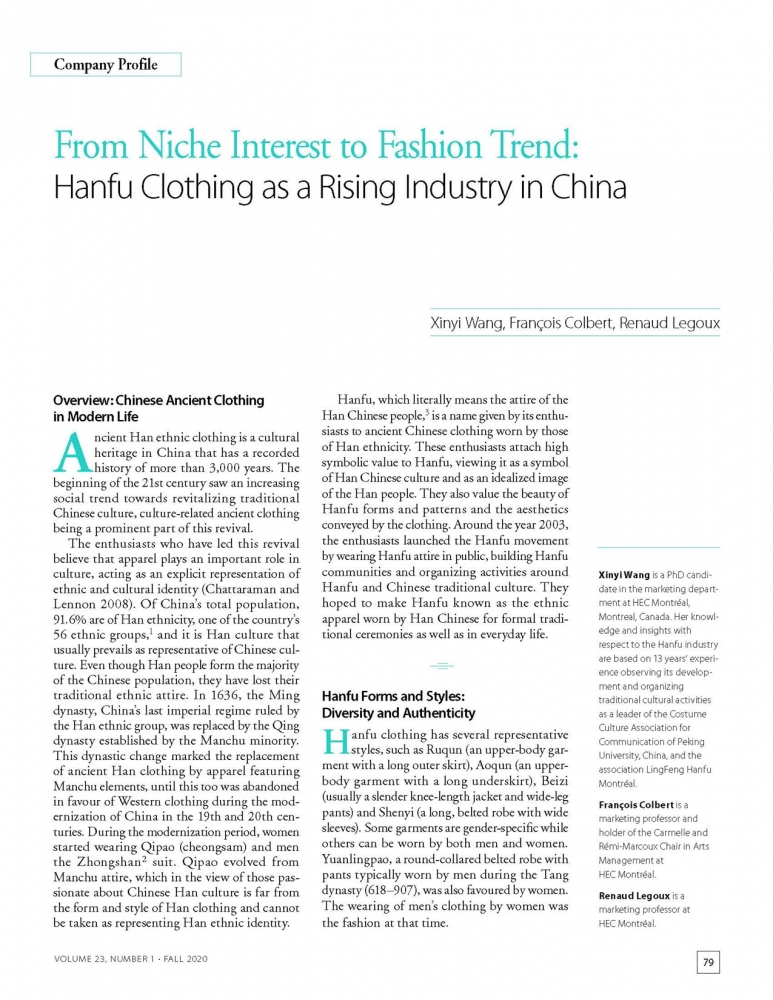From Niche Interest to Fashion Trend: Hanfu Clothing as a Rising Industry in China
Product: Article
$21.00 CA
Xinyi Wang, François Colbert, Renaud Legoux
Xinyi Wang is a PhD candidate in the marketing department at HEC Montréal, Montreal, Canada. Her knowledge and insights with respect to the Hanfu industry are based on 13 years’ experience observing its development and organizing traditional cultural activities as a leader of the Costume Culture Association for Communication of Peking University, China, and the association LingFeng Hanfu Montréal.
François Colbert is a marketing professor and holder of the Carmelle and Rémi-Marcoux Chair in Arts Management at HEC Montréal.
Renaud Legoux is a marketing professor at HEC Montréal.
ABSTRACT
Begun by a small group of enthusiasts for the benefit of a limited connoisseurs’ market, the cultural trend of Hanfu is being adopted by more and more young people in China. Inspired by traditional Han clothing, the trend is aimed at using the representative attire to recreate a tradition of ethnic and cultural identity. This 14-billion-yuan industry is still on the rise, but not without raising questions about authenticity and about representing an ethnic majority in China’s population while overlooking its minorities. What strategy should Hanfu companies adopt when the market is flooded with low-cost imitations? How should organizations dedicated to Hanfu heritage manage the tension between popularity and authenticity? These challenges have implications for the different stakeholders.
KEYWORDS
Hanfu clothing, market development, new industry, growth management
RÉSUMÉ
Lancée à l’origine par un groupe d’enthousiastes pour un petit marché de connaisseurs, la mode du Hanfu est de plus en plus populaire auprès des jeunes en Chine. S’inspirant des vêtements traditionnels de la dynastie Han, cette tendance vise à utiliser ces tenues caractéristiques pour recréer une identité ethnique et culturelle. Cette industrie de 14 milliards de yuans est en plein essor, mais soulève des questions sur l’authenticité du phénomène ainsi que des effets de la représentation d’une majorité ethnique au sein de la population chinoise, qui se ferait au détriment des minorités. Quelle stratégie les compagnies adhérant au mouvement Hanfu doivent-elles adopter, alors que le marché est inondé d’imitations à bon marché? Comment les organisations vouées à la préservation de l’héritage Hanfu peuvent-elles trouver l’équilibre entre popularité et authenticité? Ces défis ont d’importantes implications pour les différentes parties prenantes.
MOTS CLÉS
Mode vestimentaire Hanfu, développement des marchés, nouvelle industrie, gestion de la croissance
RESUMEN
En China, creciente número de jóvenes están adoptando cada vez más la tendencia cultural Hanfu, iniciada por un pequeño grupo de entusiastas y destinada a un mercado limitado de conocedores. Inspirada por la vestimenta tradicional Han, el Hanfu se inspira en la ropa representativa para recrear una tradición de identidad étnica y cultural. Esta industria de catorce mil millones de yuan sigue en auge, pero no sin plantear preguntas sobre su autenticidad y sobre el hecho que es representativa de una mayoría étnica de la población china, dejando de lado sus minorías. ¿Qué estrategias deberían propiciar las empresas Hanfu ante un mercado que se encuentra inundado de imitaciones baratas? ¿Cómo las organizaciones dedicadas al patrimonio Hanfu deben manejar la tensión entre popularidad y autenticidad? Estos desafíos tienen sus incidencias sobre en los distintos interesados.
PALABRAS CLAVE
Vestimenta Hanfu, desarrollo de mercado, nueva industria, gestión de crecimiento

